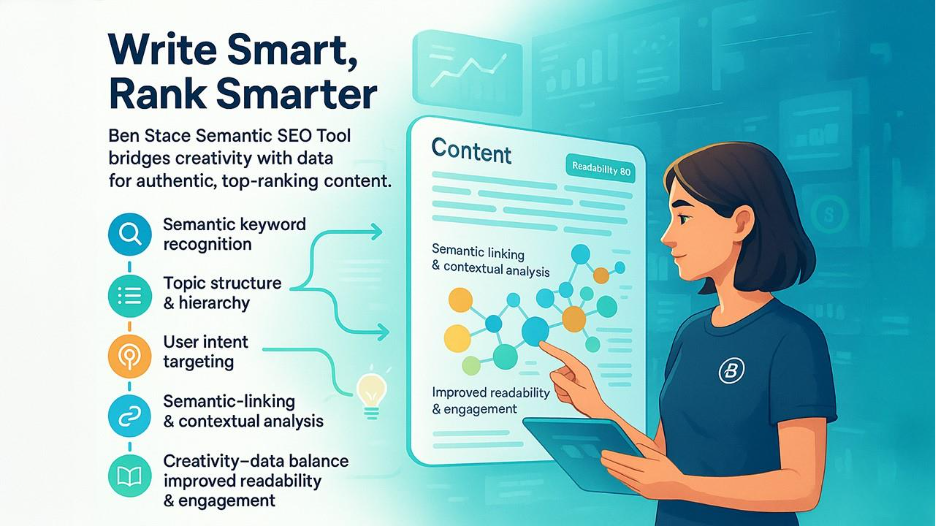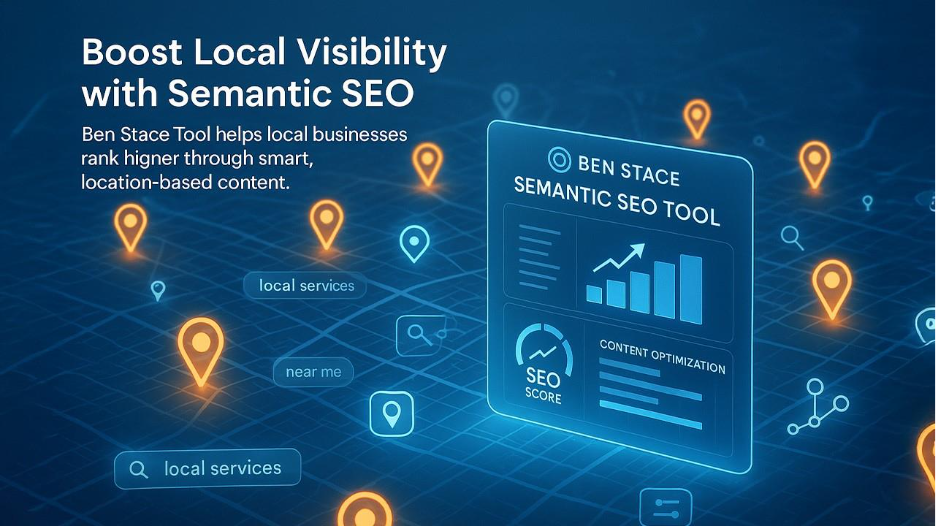In today's fast-paced digital landscape, Search Engine Optimization (SEO) is a driving force behind building successful high-quality websites that boost traffic. To remain competitive in the industry, it has become crucial to go beyond just keywords and basic strategies. For content creators and writers aiming to drive organic traffic and enhance their search engine rankings, embracing advanced SEO strategies is a necessity. This is where Ben Stace Semantic SEO Writing Tool comes into the picture. It is a game-changing tool that constantly revolutionizes the way you create content and improves keyword optimization.
Achieving a higher search engine ranking isn't only about keyword stuffing anymore. It is about writing meaningful, in-depth content that truly has the ability to resonate with search engines. Ben Stace Semantic SEO Writing Tool has emerged as an innovative and powerful tool to improve search engine rankings.
This article will discuss everything that you need to know about Ben Stace Semantic SEO Writing Tool and how it is revolutionizing content creation in this competitive market.
What is the Ben Stace Semantic SEO Writing Tool?
It is an AI-driven platform especially designed for writers and content creators to help with high-quality, optimized search and algorithm-friendly content. It detects semantic gaps, suggests relevant topics, and optimizes content to enhance its overall quality. By focusing on search intent, context, and topic depth, it aims to achieve higher rankings on search engines. The goal is to empower writers to create content that appeals to both search engines and human readers.
Ben Stace Semantic SEO Writing Tool: Key Features

By applying modern SEO principles, it assists in writing content so that it can rank based on relevance, not redundancy. It offers some key features, such as
- Recognize semantically relevant terms used in search engines.
- Structures content according to main topic and subtopics.
- Ensures that every piece targets a particular user intent.
- Builds semantically rich, interlinked content.
- Bridges the gap between creativity and data.
- Makes content engaging & authentic.
- Removes keyword stuffing and unnecessary or irrelevant words.
- Helps avoid lower rankings on Google.
- Improved readability with enhanced user experience.
- Contextual and conceptual keyword analysis.
How Does the Ben Stace Tool Do Semantic SEO?
The Ben Stace Semantic SEO strength lies in its ability to build topical maps—a clearly structured blueprint of interconnected subtopics that supports the main topic. Let's look at how the Ben Stace tool does semantic SEO:
1. Begin with Topic & Entity Research
It starts by analyzing the main topic (what the content is about) and its relevant entities (concepts, audience, tools, etc.).
2. Build Topical Maps & Content Clusters
The Ben Stace tool creates a visual plan that consists of pillar pages and supporting cluster content. The pillar page completely covers the main topic. Cluster topics divide it into detailed subsections.
3. Emphasizes User Intent & Search Behavior
Ben Stace tool always keeps user intent in mind while writing content. He asks if the content is supposed to be informational, navigational, or transactional. Depending on preference, it structures the content accordingly. This results in higher content rankings and attracts the right audience.
4. Use of Keywords & NLP
Unlike conventional tools, Ben Stace Semantic SEO writing tool does not depend on keywords alone. Instead, it uses semantic keywords, terms, or phrases that are naturally associated with the core topic. This reflects how humans communicate and what terminology they use to search for any content.
5. Question-Style Headings & Featured Snippets
It drafts its content using question-style headings so that it appears in featured snippets. It makes it easier for people to find what they are looking for. It leads to increased visibility and helps content to stand out on Google’s result page.
6. Smart Contextual Interlinking
To guide users through the topic or other related pages, it creates contextual internal links. This improves on-site metrics such as time spent on the website, semantic relevance, and crawl depth, and increases click-through rate (CTR).
7. Keeps Content Updated & Aligned
Fresh and timely updated content ranks higher on Google. The tool updates the content regularly to remove outdated facts or data and add new information. It adds new sections or questions. This improves the readability and structure of your writing. It helps keep content relevant and competitive.
How Does It Work?

Let’s see how the Ben Stace Semantic SEO writing tool helps writers to create SEO-optimized content:
- Enter your main topic/title or focused keyword.
- The system analyzes diverse, best-performing articles and their semantic structure.
- Compare your writing against collected data.
- Highlight gaps and areas in your content that need improvement.
- Recommends relevant terms or keywords to include, formatting, and problems that your writing should address with its solution.
Why Does a Local Business Need the Ben Stace Semantic SEO Writing Tool?
If you are running a local business or just a startup company, using semantic SEO can be a game-changer for your business. The Ben Stace Semantic SEO Writing Tool can help local businesses rank higher compared to broader national competitors in certain niche or location-based searches.
Benefits:
- Increased visibility in Google Map Pack.
- Improved rankings for “near me” searches.
- Drive traffic growth with purchase intent.
- Value-driven content increases customer engagement.
This is why businesses, whether big or small, rely on semantic SEO to improve their website’s search engine rankings. The right use of semantic keywords and topical content clusters helps increase topical authority. This results in the growth of organic traffic, stronger on-page SEO, and a reduced bounce rate.
The Future of Semantic SEO
As artificial intelligence (AI) keeps redefining how search engines evolve and interpret content, semantic SEO will play an even greater role in the foreseeable future. Ben Stace Semantic SEO Writing Tool is designed for this evolution. It can quickly adapt to changing algorithms to better understand the underlying relationship between topics, concepts, entities, and user behavioral patterns.
In the future, content optimization won’t just be limited to keywords and rankings. It will be more focused on contextual authority. Semantic SEO helps creators to announce and establish their brand presence as an authentic source. It ensures not just visibility but also trust that your brand will foster among customers.
Conclusion
Ben's uses modern SEO methods that perfectly align with evolved search engine requirements. Google doesn’t reward long sentences with keyword stuffing anymore. It evaluates your topic in-depth and analyzes whether it matches the user’s search intent or not. Search engines use natural language processing (NLP) and search query understanding to identify if your topic covers all the relevant information and how well it answers the questions.
Ben Stace's Semantic SEO Writing Tool helps to make this possible. It understands the relationship between terms and topics and assists in writing optimized content that meets Google’s standards. It helps writers empower their content. It ensures that the content is error-free, SEO-friendly, meaningful, and easily discoverable.



.png)

.png)
.png)

